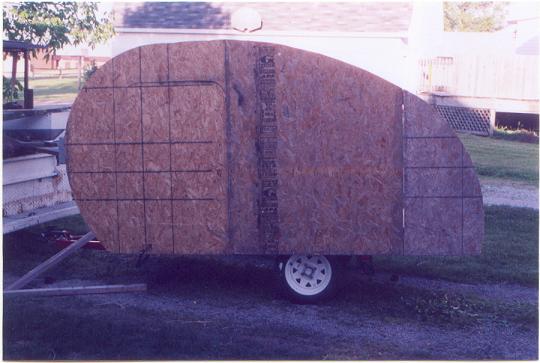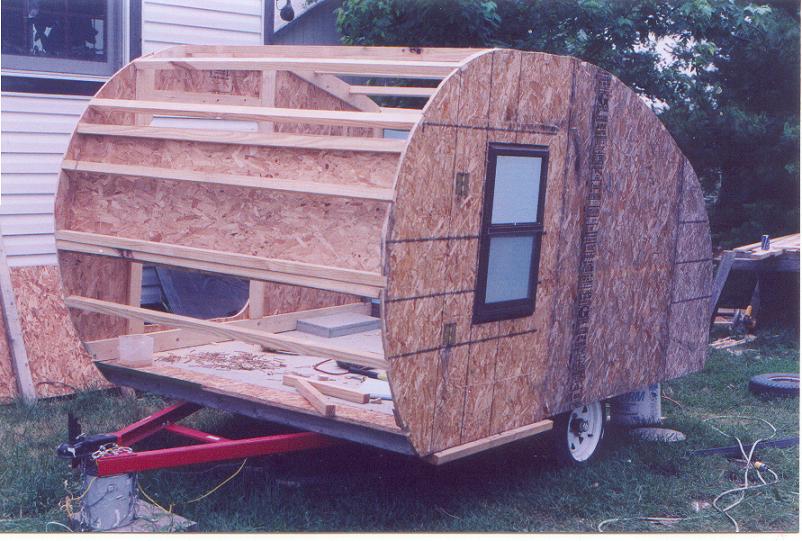Page 1 of 1
Planning stages, wall construction, design ideas...

Posted:
Tue Jan 10, 2012 10:37 amby prof
I am beginning the planning of my first Teardrop. I am looking at a pretty standard shape, custom trailer, 5'6"x9'. I like the Camp Inn designs and will probably clone one of those. I am not sure if I will keep the walls under four feet of if I should build a little taller.
It looks like there are two basic methods for wall construction. Either stacked plywood or the more common stick framed. It looks like the stacked plywood is the easier of the two. Insulation becomes the concern. I am in Texas and don't plan on doing much cold weather camping but I would like to be able to efficiently heat and cool my trailer.
Does anyone have any numbers relating to the different R values for different construction techniques?
This is my first post. I have done plenty of reading. Hopefully I will get some designs mocked up soon.
Dave

Posted:
Tue Jan 10, 2012 9:22 pmby Woodbutcher
I have built 2 so far, with the third just underway. All three different. The first on was a Woody style with 1/4" on each side with 1" ridged insulation in the middle. There is a stick frame inside. The roof had 1 1/2" with 1/8th" on the inside and 2 layers staggered of 1/8th" on the outside. Heating and cooling this one is easy.
Second one has 3/4' plywood walls. No insulation with aluminum all over it. The ceiling has 1 1/2" insulation with 1/8th" on both sides. Also easy to heat. Have not used it in the real hot weather.
Third one will have 1/4" sides, with a stick frame on 12" centers and no insulation. The sides will be woody design and some extra wall strength will come from the "Woody " frame. Ceiling will be stick built with 1/4" roof and an aluminum covering . I may use auto headliner as an insulation, more for noise then temperature.
Good luck with your build. Keep in mind when we tent camped years ago, we put the Coleman lantern in the tent to warm it up before bed on cold nights. So as long as the trailer is reasonably air tight just your own body heat will keep you warm. The key is "reasonably" air tight. Real air tight will kill you.

Posted:
Wed Jan 11, 2012 12:42 amby Senior Ninja
We built ours with the walls horizontal. That made insulating and gluing easy.
Also installed all the wiring while the walls were on the bench. Used 5/8 and 1/4 plywood with one inch of foam insulation. Makes for a warm and quiet trailer. Used a key way in the bottom of the wall to slip over a key glued and screwed to the floor. Everything was covered with three coats of lovingly applied varnish to show off the birch plywood.
Steve

Posted:
Wed Jan 11, 2012 11:13 amby prof
I am leaning toward the stacked 3/4" plywood. This seems like the quickest and easiest method. If I use a quality grade of plywood I will already have the finished surface inside and out. The top will be stick built with spars and insulation.
It is going to be a relatively quick build. I am planning a trip to Colorado in June. The idea is to leave the galley build out until last so I can get it camp-able quickly. I will create a wiring chase to make it easy to add circuits later. I will also buy pre-made doors so I don't have to custom build my doors. Right now I am leaning toward an automotive paint finish to prevent the cost or need for Al sheeting (which is what I really want).
Point taken about it being to tight. I don't plan to burn anything in the trailer but I will at a monoxide detector just in case. I want to wake up in the morning.

Posted:
Wed Jan 11, 2012 3:18 pmby Senior Ninja
Prof, you are on the right track and you seem to have it pretty well thought out.
We left the bottom panel out so we could slide the mattress out to make the bed. Much easier once it's outside. That's part of the fun building it just the way you want.
We love pictures here. It's one of the best things about this site.
Good luck with the build.
Steve

Posted:
Wed Jan 18, 2012 10:17 amby prof
We left the bottom panel out
@Senior Ninja -- What bottom panel? I am having trouble picturing this.
I think I am going to use two sheets of 3/4 ply on each side. I'll cut the inside smaller to create a rabbet to make attachment of the spars, roof, and connection to the base easy. If I join two 5x5 sheets of plywood I think I can get the profile I want with relatively little waste.
I am going to build a bunk where most people install cabinets to give my daughter a place to sleep. I should have 5-10 years before she hits the 5' mark and won't fit sideways in the trailer.

Posted:
Wed Jan 18, 2012 10:50 amby Oldragbaggers
Prof,
If you are concerned at all about weight, you might want to rethink that 2 sheets of 3/4" on each side. That's gonna be mighty heavy.

Posted:
Wed Jan 18, 2012 11:14 amby prof
Weight is not my main concern but I am not out to build an anchor.
I will be pulling with a full size truck (Ford Expedition right now).
I am looking for a dry weight of 1000lbs. Plus or minus 200 lbs. would be acceptable for me.

Posted:
Wed Jan 18, 2012 12:15 pmby bobhenry
What I have seen here on the forum is most of tha 5x9 wood framed teardrops have been closer to the 1500 pound range. 3/4 plywood weight 60 - 72 pounds per 4x8 sheet depending on plys and type of binders.
Your 2 extra 5 x 9 pieces of 3/4 will add 150 to 175 pounds above that.
Chubby was built with a single 3/4 ply and laps were joined with 1 x 4 pine boards inside. I simply screwed thru sheet A and sheet B into
the 1 x 4 to join the sheets vertically. The 1 x 4 left a void for 1/2 depth electrical boxes and 3/4 foam insulation. It was then covered with 1/4 " Luan Inside and out. So I have almost as much wood involved as you. Chubby scaled out at 1830 pounds loaded to the gills for camping.



Posted:
Wed Jan 18, 2012 1:58 pmby jstrubberg
When you say two sheets of 3/4 ply per side, are you talking about two sheets for the outside or one inside, one outside? Either way 3/4 inch plywood is very heavy and a lot more than you need for a trailer like this. You could use 1/4 inch and get all the structural strength you need.
From the reading I've done of builds here, it looks like you are looking at the right spots to save time. The galley, doors and finish seem to consume the biggest chunks.

Posted:
Wed Jan 18, 2012 3:46 pmby prof
If I use these doors,
Woodlandtrailerfactory I would want a thickness of 1 1/4"
I could use 3/4" and 1/2" ply sandwiched. That would save a little weight... I am thinking of sandwiching foam between two sheets of 1/4 for the bottom. The top would be 1/8" skinned over spars with insulation.
I know that everyone's tendency is to overbuild and I am sure I will do the same. I just can't decide if stick building the walls will make that much difference. If it costs me 150 lbs. to shave a week or two out of the build time that is ok.
Guess it is time for more math.

Posted:
Wed Jan 18, 2012 4:39 pmby StPatron
prof wrote:If I use these doors, I would want a thickness of 1 1/4"
That's
only needed in the immediate door framing area, nowhere else.
Why not select the minimal thickness you want for the wall, build it and then beef up the door framing area on the interior to accommodate the door thickness requirement? Only applying the 1/2" in that area as a spacer of sorts.